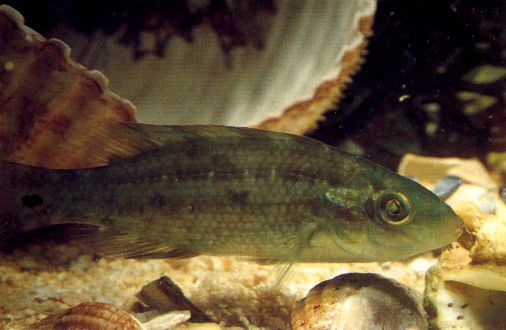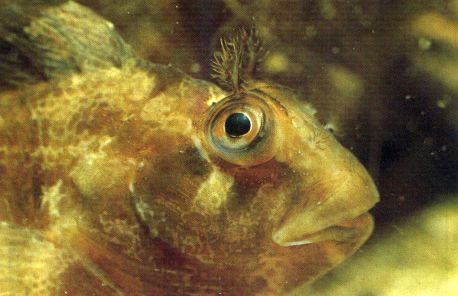
 |
with Jane Lilley
Most divers in the south of England have dived under Swanage pier.
It is a long heavy structure which looms low over the
water, supported on massive wooden pilings. The seabed is clear
sand with patches of rocks and pebbles; close to the pier it is
scattered with miscellaneous objects ranging from heavy girders to
old benches, and further away are numerous boat moorings.
The bottom slopes imperceptibly, and the water is very shallow - three
to five metres at most states of the tide. Among the
moorings are varying amounts of weed (varying with the season and between
one spot and another): loose masses of mixed green and red
algae eight inches or so high, small areas of eelgrass, the immigrant Japweed,
Sargassum,
and occasionally the annual kelp Saccorhiza polyschides, with its
curious knobbly bulbous holdfast.
Novice Dive Site
Under the pier itself, the fauna and flora are probably heavily influenced
by the number of divers. Many clubs bring their
novices here for a first dive in shallow, quiet conditions, and the
diving school on the pier takes complete beginners in for
'Try-a-Dive' sessions. In addition, some of those who have dived
further out have a potter around under the pier on the
remaining air in their cylinders. On summer weekends, the total
must be considerable. As a result, any life under the pier
itself must either avoid or tolerate innumerable hands poking and feeling,
and survive the thoughtless or uncontrolled swipes
of many large fins. This is almost certainly why the lower parts
of the piles - the sections most abraded by divers - are
almost bare of weed and support a surprisingly sparse and restricted
sessile fauna. Plumose Anemones (Metridium senile)
were in the past reported to be very abundant on the piles, but last
year I saw only one small group, high up by the weed collar
that survives around the low water mark. Nevertheless, for the
diver who stops to look, and who ventures away from the dark but fairly
easily navigated new pier to find the ruined piles of the old one (use
a surface marker buoy, RIBs and hardboats use the area), there is a great
deal of life to identify and watch.
 Juvenile Corkwing Wrasse
Juvenile Corkwing WrasseLast time I dived there, in August, some of the Ballan Wrasse were a
striking pale green, a colour which merged well with the
algae, but which is uncommon (absent?) in larger specimens in deeper
water. They can grow to twelve inches long; these were
youngsters of about six inches.
Fish Shoals
There are often shoals of young fish in midwater under and around the
pier. Bib (also called Pouting: Trisopterus luscus)
are easy to recognise, with dark and light vertical-striped bodies
and a barbel under the lower jaw. They like enclosed
places, and are typically found inside or close to wrecks, in natural
crevices or under ledges, so they probably feel at home underneath the
pierhead among the massive piles and struts. There are also often
shoals of smallish, more or less silvery fish which, like the bib, have
three triangular fins on their backs; they must be juveniles of whiting,
pollack or other members of the cod family. It is possible for divers
to identify the species by looking for details like chin barbels and the
shape and position of the lateral line, but more interesting just to watch
the behaviour of the shoals as they manoeuvre in formation, advancing slowly,
wheeling, breaking and reforming their flanks, gleaming silver as they
turn.
Bottom-living fish are entirely different in appearance and habits.
Their colouring is more likely to resemble sand and stones than open water
and silvery surface; instead of relying on speed and the safety of numbers
of avoid predators, bottom-dwellers usually live singly and dive into holes,
bury themselves, or trust in stillness and an inconspicious appearance
to escape detection.
 Tompot Blenny
Tompot BlennyDragonets
I have trouble identifying most of the small mottled-brown bottom-living
fish. An aquarist can watch his specimen at leisure and from the
side, comparing it with illustrations and descriptions until he is sure
of its identity. A diver usually sees these fish from above and probably
at a greater distance, and has to wait until the end of the dive to look
it up and discover that he did not notice or cannot remember the crucial
features. The Dragonet
(Callionymus sp.) is one such fish, distinctive once you know it,
but very difficult to identify from books.
Pipefish
Pipefish are always fun to watch, and I have seen both the Greater
Pipefish (Syngnathus acus), and what was probably the similar
but much smaller Nilsson's Pipefish (S. rostellatus) at Swanage.
Both have the head of a seahorse, with a long narrow
snout ending in a tiny mouth at the tip; the Greater Pipefish has a
longer head than Nilsson's. Behind it is a very long narrow body,
most unfishlike. There is a functional-looking dorsal fin halfway
down the back, but the tail fin is just a tiny fan at the tip of the long
tapering tail, and the only other fins are a pair of little pectoral fins
just behind the head. They swim slowly and apparently very ineffectively
by undulating the dorsal fin; the pectorals also work furiously, but the
tail appears to be irrelevant.
Pipefish can be handled (very carefully, to avoid injuring them), and usually seem unworried by this. Instead of scales, the body and tail are apparently enclosed in rows of plates, making them feel slightly angular. They often live in seaweed, and can be difficult to spot when motionless. It is difficult to imagine what the tiny mouth and long snout are designed to feed on: apparently they suck in minute planktonic animals, usually tiny crustaceans or fish.
The males of both species have an elongate pouch, and the female lays
her eggs into it; a 'pregnant' male has a long double row
of irregular bulges along the underside of his tail. He carries
them around until they hatch, when the young, only an inch or
so long, are released to fend for themselves.
Sea Anemones
Familiar animals can still surprise. Last summer, Snakelocks
Anemones (Anemonia viridis = A. sulcata) were very
numerous, attached to the weed instead of the more usual solid substrate.
The column was clearly visible, with vertical lines or ridges, which
perhaps marked the position of internal partitions (mesenteries).
They varied in colour, but most were yellowish or pale beige, without the
green tinge given by the symbiotic algae which usually live in their tissues
why might these have been absent? certainly not lack of light).
Snakelocks Anemones, with Pimplet Anemones in the foreground
It was not clear what had provoked so many of them to divide at such
a relatively small size. Shortage of food could be a
cause, a small anemone requiring less food than a large one. Or, conceivably,
the inherent instability of an algal frond as a support; the weight
of an anemone that grew too large might overturn its frond, dumping the
anemone upside-down on the sand.
Can anyone shed any light on this behaviour?
At Night
A well-known site can be quite different at night. Many animals appear which are hidden by day; others behave quite differently. When I dived after dark at Swanage last August, the Dragonets I had watched by day were still active, but reacted differently to disturbance. By day, they had relied on cryptic colouration and stillness for concealment when alarmed; now they frequently buried themselves, something I had not noticed at all by day. They apparently scooped the sand out from under themselves and threw it over their flat backs with the huge pectoral fins; probably the pelvic and anal fins, under the body, were used as well. It was very effective; they sank rapidly downwards, the sand spread across their backs, and within seconds only the eyes were visible. I will have to watch them again to find out whether this is a real difference between day and night-time behaviour or not.
Squids
In mid-water under the pier I was surprised to meet a little pink squid
(possibly Loliga forbesi).
Apparently they are quite
common in late summer when the water is warm. It was about six inches
long, with a torpedo-shaped body and two triangular fins near the back;
the head had big eyes and a set of short tentacles bunched together.
It appeared to be hunting, although
we did not see it catch anything. Much of the time it used its
fins to swim slowly forwards, well above the bottom, with is
body horizontal; but several times it turned to a vertical position,
head down, a few inches above the sand. What exactly
it did was not obvious, but a little circle of sand immediately below
it suddenly moved outwards, having a shallow crater;
presumably the squid had shot a jet of water at the sand from its hyponome
(funnel), although how it did this without jetting
itself backwards was not clear. Eventually it became unhappy
about being watched and jetted rapidly away, tail first.
 Velvet Swimming Crab
Velvet Swimming CrabScavengers
More Netted Dogwhelks were converging on the feast, ploughing steadily
through the sand with their syphons extended, following the scent of carrion.
They leave a shallow furrowed trail behind them in the sand, much more
visible in the oblique light of a torch than by day; the sand was covered
with these and other trails. One showed where a very small flatfish
had been
hunting, 'walking' across the bottom by regular undulations of the
fins round its sides, and leaving a neat double row of oblique marks where
the fins had pushed against the sand.
 Netted
Dogwhelk
Netted
Dogwhelk
Dead fish obviously featured largely on the scavengers' menu. What
at first sight appeared to be a small mound of netted
dogwhelks proved to contain the shredded remains of another small fish,
while a third had been found by a large Spiny Spider
Crab (Maja squinada) Many animals, curiously, ignore divers'
torchlight, but this crab was not going to risk us stealing its
dinner. As soon as the torch beam settled on it, it picked up
the fish in its pincers, held it firmly underneath its body, and
set off rapidly to find somewhere quieter.
Lobster
I had never seen a Lobster, Homarus gammarus,
under the pier before, but a medium-sized one was walking around a huge
girder. By day you often see them on wrecks and in rocky areas, looking
suspiciously at you out of a safe hole: eyes, a complex of mouthparts,
and two immensely long red antennae, flanked by the business ends of a
pair of formidable pincers. Seen properly, a live lobster is very
attractive, blue-black with bright blue markings and sometimes orange tinges.
This one was walking delicately across the bottom, antennae extended, presumably
searching for food - they are reported to be scavengers by preference
- and ignored us until I made an incautious movement and it took fright,
scurrying rapidly sideways under a beam. Occasionally, if caught in the
open without adequate cover, a lobster will swim, flexing its tail fin
under its body and beating it rapidly; this propels the animal through
the water backwards and very rapidly. How it sees where it is going
I have no idea, but it seems to be able to; the last one I saw scudded
along for some distance, swung unerringly into a secure cranny, and vanished.
 Galathea
squamifera
Galathea
squamiferaSquat Lobsters are strongly nocturnal, and by day are usually glimpsed
in the depths of crevices or exposed by turning over a
stone. They emerge as the light begins to dim, and sometimes
if you dive as the sun is setting it seems that a squat lobster is
emerging from under every cobble.
Photograph by Chris Tan (Bath)
|
|
|
|
|
|
|
|
Membership Form |
|